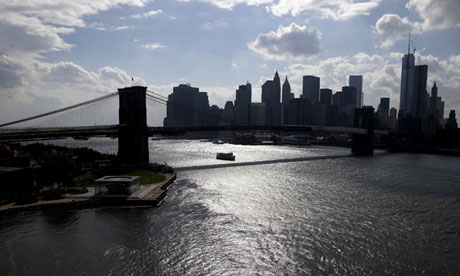no, it's not public bicycles . . .

New York City's mayor has unveiled an "incredibly ambitious" $20bn proposal to transform how America's largest city protects itself from global warming after being jolted by a deadly superstorm last year.
Removable flood walls would be set up for much of lower Manhattan, home of the financial district. A levee up to 20ft high would guard part of Staten Island and dunes would be built to strengthen the city's Atlantic shoreline.
"This is urgent work, and it must begin now," Michael Bloomberg said in a speech on Tuesday. "Piece by piece, over many years and even decades, we can build a city that's capable of preparing better, withstanding more and overcoming anything."
The sweeping proposals are a sizeable step up in scale and urgency for a mayor who has for years emphasised the threat climate change poses to the city, which has 520 miles of coastline. The storm sent a record 4.27-metre (14ft) storm tide gushing into lower Manhattan.
With Bloomberg's term soon coming to an end, it remains to be seen how the ideas will fare in a future mayoral administration and what kind of support financial and otherwise they might get from the federal government, not to mention from New Yorkers themselves.
Bloomberg acknowledged that some of the ideas could prove controversial, but said: "If we're going to save lives and protect the lives of communities, we're going to have to live with some new realities."
The recommendations draw from updated predictions from the New York City Panel on Climate Change, a scientists' group convened by the city that estimates an average day in New York will be hotter by the middle of the century. With local waters up to two-and-a-half feet higher than they are today, 8% of the city's coastline could see flooding just from high tides, the group estimates. Most of that coast is in a relatively undeveloped area near a bay.
The city has required some new developments in flood zones to be elevated and has restored wetlands as natural barriers, among other steps.
"Sandy, obviously, increased the urgency of dealing with this and the need to plan and start to take concrete (!) steps," the deputy mayor, Caswell Holloway, said on Monday.
To see the mayor's presentation: http://p.nytimes.com/email/re?locati...71045851120573

New York City's mayor has unveiled an "incredibly ambitious" $20bn proposal to transform how America's largest city protects itself from global warming after being jolted by a deadly superstorm last year.
Removable flood walls would be set up for much of lower Manhattan, home of the financial district. A levee up to 20ft high would guard part of Staten Island and dunes would be built to strengthen the city's Atlantic shoreline.
"This is urgent work, and it must begin now," Michael Bloomberg said in a speech on Tuesday. "Piece by piece, over many years and even decades, we can build a city that's capable of preparing better, withstanding more and overcoming anything."
The sweeping proposals are a sizeable step up in scale and urgency for a mayor who has for years emphasised the threat climate change poses to the city, which has 520 miles of coastline. The storm sent a record 4.27-metre (14ft) storm tide gushing into lower Manhattan.
With Bloomberg's term soon coming to an end, it remains to be seen how the ideas will fare in a future mayoral administration and what kind of support financial and otherwise they might get from the federal government, not to mention from New Yorkers themselves.
Bloomberg acknowledged that some of the ideas could prove controversial, but said: "If we're going to save lives and protect the lives of communities, we're going to have to live with some new realities."
The recommendations draw from updated predictions from the New York City Panel on Climate Change, a scientists' group convened by the city that estimates an average day in New York will be hotter by the middle of the century. With local waters up to two-and-a-half feet higher than they are today, 8% of the city's coastline could see flooding just from high tides, the group estimates. Most of that coast is in a relatively undeveloped area near a bay.
The city has required some new developments in flood zones to be elevated and has restored wetlands as natural barriers, among other steps.
"Sandy, obviously, increased the urgency of dealing with this and the need to plan and start to take concrete (!) steps," the deputy mayor, Caswell Holloway, said on Monday.
To see the mayor's presentation: http://p.nytimes.com/email/re?locati...71045851120573

Comment